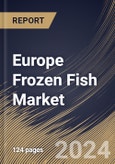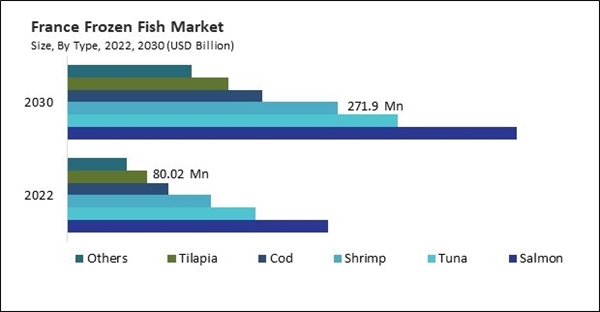As consumers continue to explore convenient and flavorful options in the frozen fish market, the availability of various shrimp types caters to a wide range of culinary preferences, driving sustained demand and innovation within the industry. Therefore, the Spain market consumed 61.3 kilo tonnes shrimp in 2022.
The Germany market dominated the Europe Frozen Fish Market, by Country in 2022, and would continue to be a dominant market till 2030; thereby, achieving a market value of $2,457.6 Million by 2030. The UK market is exhibiting a CAGR of 5.4% during (2023 - 2030). Additionally, The France market would experience a CAGR of 7.1% during (2023 - 2030).
Frozen fish is a primary ingredient in an extensive range of ready-to-cook products that cater to consumers seeking convenient and time-saving meal solutions. Breaded fish fillets, battered fish portions, and marinated seafood skewers leverage frozen fish's convenience and extended shelf life. These products often feature value-added elements, such as seasonings or coatings, enhancing the overall eating experience and expanding the market's appeal to diverse consumer preferences.
The food service industry has embraced the adoption of frozen fish due to its reliability and convenience. Restaurants, catering services, and other food establishments benefit from the consistent quality and availability of frozen fish, allowing them to incorporate seafood into their menus without the challenges associated with fresh seafood procurement and storage. This adoption has contributed to the widespread integration of frozen fish in culinary creations across various cuisines.
Rising disposable income allows consumers to explore Europe's premium and value-added frozen fish products. In Europe, frozen fish products provide a time-efficient solution for individuals seeking to prepare effortless meals without sacrificing quality, as consumers with higher incomes are inclined to pay for convenience. Thus, all these factors will uplift the regional market’s expansion in the coming years.
Based on Distribution Channel, the market is segmented into Supermarkets & Hypermarkets, Convenience Stores, Online Retail, and Specialty Stores. Based on Type, the market is segmented into Salmon, Tuna, Shrimp, Cod, Tilapia, and Others. Based on countries, the market is segmented into Germany, UK, France, Russia, Spain, Italy, and Rest of Europe.
List of Key Companies Profiled
- Dongwon Enterprises Co. Ltd.
- Mowi ASA
- Zoneco Group Co., Ltd.
- F.C.F. Fishery Co., Ltd.
- Nippon Suisan Kaisha, Ltd.
- Chicken of the sea International (Thai Union Group PLC)
- Nueva Pescanova, S.L (Abanca Corporación Bancaria, S.A.)
- Tassal Group Limited
- High Liner Foods
- SalMar ASA (Kvera AS)
Market Report Segmentation
By Distribution Channel (Volume, Kilo Tonnes, USD Billion, 2019-2030)- Supermarkets & Hypermarkets
- Convenience Stores
- Online Retail
- Specialty Stores
- Salmon
- Tuna
- Shrimp
- Cod
- Tilapia
- Others
- Germany
- UK
- France
- Russia
- Spain
- Italy
- Rest of Europe
Table of Contents
Companies Mentioned
- Dongwon Enterprises Co. Ltd.
- Mowi ASA
- Zoneco Group Co., Ltd.
- F.C.F. Fishery Co., Ltd.
- Nippon Suisan Kaisha, Ltd.
- Chicken of the sea International (Thai Union Group PLC)
- Nueva Pescanova, S.L (Abanca Corporación Bancaria, S.A.)
- Tassal Group Limited
- High Liner Foods
- SalMar ASA (Kvera AS)









